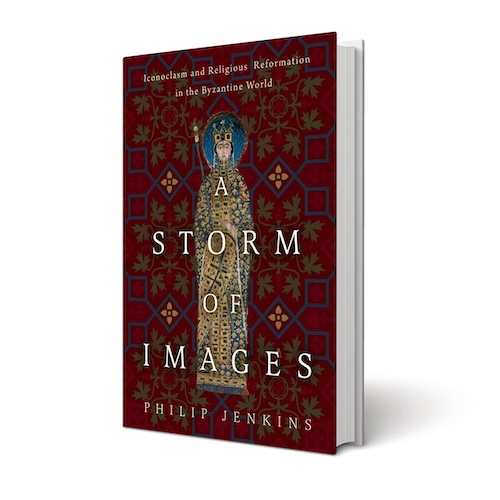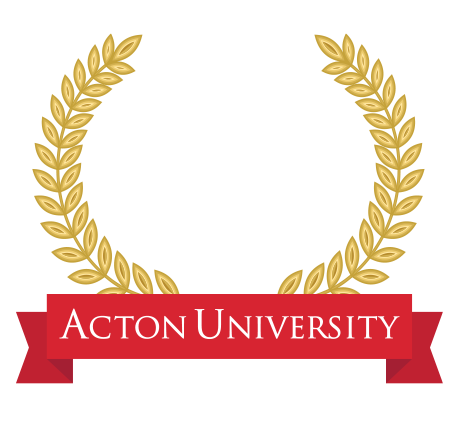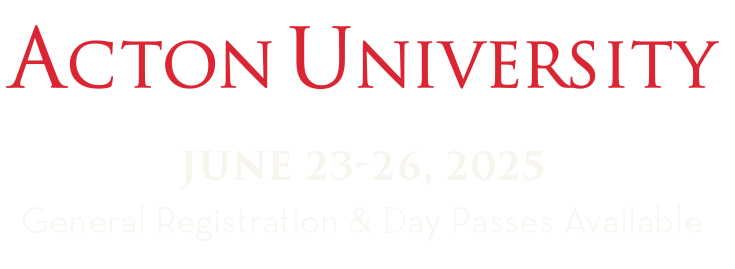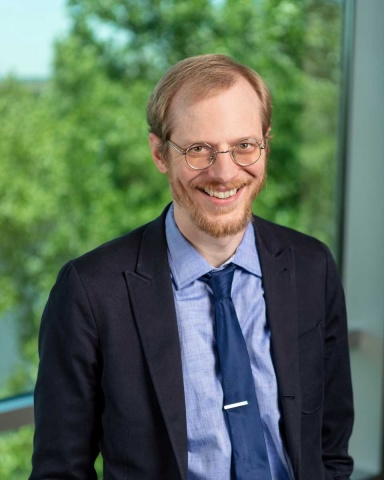I grew up in an aniconic, evangelical church. “Iconoclastic” would be inaccurate, because to my knowledge no one there had literally ever smashed any sacred images (“iconoclast” comes from eikon, meaning “image,” and klastes, meaning “smasher”). They just didn’t have any and didn’t want any.
Church history is filled with controversies and scandals, few more demoralizing than the fight over images in worship. Is it possible there was merit to the arguments of both sides—the iconoclasts and the iconodules? A new book tries to make the case.

Iconoclasm and Religious Reformation in the Byzantine World
By Philip Jenkins
(Baylor University Press, 2023)
Well, that’s not entirely true. Every Christmas, the church put on a spectacular musical pageant, including costumed actors portraying the Virgin Mary and St. Joseph. During Holy Week (they didn’t call it that), they staged a performance of the life of Christ, again visually portraying our Lord. In Sunday school, we had picture books of Bible stories. And, of course, we had felt-board Jesus.
The goal of all these visual aids was evangelism, whether of visitors or children in Sunday school. No doubt people would have been upset if Christ or the Mother of God (which they wouldn’t call her) had broken character. So, too, teachers would have sternly corrected a child who decided to scribble in the Bible storybooks or portray a comical scene involving flannel Jesus. Rightly so. Yet some of these same people also taught me that they were better than Roman Catholics, who weren’t real Christians because they “worshipped idols” of Christ, the Virgin Mary, and the saints.
As a teenager, I began to feel out of place in my childhood church. This had mostly to do with the youth-group-as-social-club approach to teenage catechesis, which taught me nothing. I was full of questions, and no one had any answers for me. I also remember having some natural talent for visual art, drawing in particular. I never developed as an artist—my mother couldn’t afford lessons—but it still bothered me that there was no place for my God-given talent in my home church. Then in college, I stayed out too late on Saturday nights and stopped going altogether.
Years later, I came back to church and started studying Bible and theology at Kuyper College, in the course of which I realized: 1) I should care a lot more about the Nicene-Constantinopolitan Creed, since it is the only statement of faith technically every Christian claims to believe; and 2) that extra Latin word (filioque) added centuries later didn’t fit into the theology of the Greek Fathers, who wrote the creed in the first place. I also discovered the ascetic tradition of the ancient Church, which had near-scientifically studied exactly how best to “work out your own salvation with fear and trembling” (Philippians 2:12). These intellectual and spiritual currents converged and swept me, like many others, toward the Orthodox Church.
I couldn’t become Orthodox unless I could get beyond my hesitancy toward icons.
But though I might assent to Orthodox dogma and benefit from asceticism, one barrier remained: all those icons! In Orthodox churches, there is a literal barrier of icons—the iconostasis—at the front of the nave. Icons are everywhere, and they aren’t just there to look at: worshippers make the sign of the cross before them, kiss them, face them when they pray, and on occasion process with them behind the priest and the cross. Some are even associated with miracles. I had a lot of baggage from my upbringing that made these practices off-putting. Couldn’t someone agree to everything else but just skip all the weird icon stuff? The Orthodox Church answered with a clear “no” in every expression of its piety. I couldn’t become Orthodox unless I could get beyond my hesitancy toward icons. Thankfully, by this time I knew exactly who to consult to determine if this could be for me: St. John of Damascus.
Reading the Cappadocian Fathers had been my first push in the direction of the Orthodox Church. If I were to transform my thinking on icons, I would have to read the foremost defender of icon veneration during the eighth and ninth centuries’ Iconoclastic Controversy, that “storm of images” Philip Jenkins refers to in the title of his new book, A Storm of Images: Iconoclasm and Religious Reformation in the Byzantine World. If the Damascene didn’t convince me, I would have to become … I didn’t know. Maybe Anglican or something.
Suffice it to say, I was convinced and did become Orthodox, taking St. John of Damascus as my patron saint. I relay all this backstory to note that I am a biased reader of A Storm of Images. Jenkins opens his book with a provocative, both-sides perspective: “In reality, both pro- and anti-image militants were innovators, seeking new forms of worship and trying as best they could to situate them within both scriptural and historical Christian tradition.” He correctly pushes hard against one-sided, 19th- and 20th-century summaries of iconoclasts as “not Philistines but conservatives wanting their religion the old way,” to quote Henry Chadwick. But in order to portray iconoclasts and iconodules (supporters of icons) on equal footing, I expected Jenkins to expose either unknown treachery on the part of the iconodules or uncredited virtue of the iconoclasts. While he does show how history is messy, the evils of iconoclasm still heavily outweigh Orthodoxy. Put simply, the facts of history Jenkins so carefully uncovers undermine the book’s stated thesis that both sides made defensible claims.
Jenkins begins by noting how the iconoclastic movement seems to have begun among Christians in Muslim-controlled Syria in the early 720s, mostly under duress, and then only briefly. With the ascent of Leo the Isaurian, a successful general, to the throne of Constantinople, however, iconoclasm became the official policy of New Rome. Leo deposed the Orthodox patriarch Germanos. Everything proceeded in largely top-down fashion, under state pressure.
Leo’s successor, Constantine V, continued his policies and branched out to suppress monasticism as well. Jenkins describes Constantine’s “near pathological hatred of monks,” who were often outspoken iconodules, by detailing how he would theatrically humiliate, torture, and murder them in the Hippodrome before crowds who, Jenkins suggests, may have been compelled to attend as well. Of course, Orthodox historians of this period do not bother with objectivity, and describe the emperor in the most devilish terms, even comparing him to pagan emperors who martyred so many Christians of the early Church. Yet, while perhaps calling him “dung-named” (Copronymos) is a little childish, the comparison to Diocletian and other anti-Christian tyrants seems quite apt to me. Sure, Constantine also claimed to be a Christian, but he still murdered Christians for show. The analogy fits.

Constantine V’s successor, Empress Irene, acting as regent for her minor son, Constantine VI, reversed the iconoclast policy of the previous 50 years, calling the Seventh Ecumenical Council in 787. Following on Jenkins’ storm analogy, we could call the roughly 20 years of her reign the eye of the storm, the brief calm before havoc continued. Irene’s hold on power was fragile, and in order to survive the infamous Byzantine intrigue, she fell into it as well, making a habit of blinding and exiling—but not outright murdering—her rivals, including her own son, who, Jenkins notes, nevertheless did die from his wounds. In her defense, her son had finally come of age and was at the center of a plotted coup, but even the chronicler Theophanes, who otherwise paints Irene as a saint, recoiled at this. As Judith Herrin summarizes, Theophanes “notes that the sky was darkened for seventeen days … which was interpreted as a condemnation of the blinding. And he concludes, ‘In this way, his mother Irene acceded to power.’” If once considered a saint, she’s absent from the Menaion (an important liturgical guidebook) and no longer venerated today.
After Irene, a series of iconoclastic emperors ruled for another generation, continuing the conflict in all its inhuman treachery, including monks and other dissenters once again being tortured, branded, exiled, whipped to death, and beheaded. Only upon the death of Emperor Theophilos in 842 and the ascent of Empress St. Theodora did Byzantium finally obtain a permanent calm from the “storm of images.”
Jenkins goes on to describe what can be reconstructed of the iconoclasts’ theology: they claimed that the making and veneration of icons violated the Second Commandment. “Constantine [V] repeatedly argues that God is aperigraphon, uncircumscribed, elevating the concept to the status of the famous Chalcedonian ‘withouts.’” Accordingly, the “final horos” of the iconoclastic council in Hieria asserted that “the unlawful art of painting living creatures blaspheme[s] the fundamental doctrine of our salvation—namely the incarnation of Christ.” The iconoclasts justified this last claim by insisting that icons could be justified only if one either divided or conflated the divine and human natures of Christ.
Suffice it to say, these points do not hold up against a close reading of scripture or church history, and St. John of Damascus, free to write from Muslim-controlled Syria, ably answered each point in the 720s and ’30s in his three treatises. He notes that the law of Moses commands the making of all sorts of images, even that they should be used in worship and honored, though not themselves worshiped. Graven images of cherubim flanked the mercy seat of the Ark of the Covenant. Icons of angels adorned the curtain separating the holy place from the most holy place in the Tabernacle (Exodus 26:31–34).
Every icon is a declaration of the Incarnation of the uncircumscribable God.
Moreover, God gave a pertinent justification for why no image of him could be created: “Take careful heed to yourselves, for you saw no form when the Lord spoke to you at Horeb … lest you act corruptly and make for yourselves a carved image in the form of any figure” (Deuteronomy 4:15–16, emphasis added). But for Christians, the story does not end on Mount Horeb. Through the Incarnation, the divine “Logos of Life” is “that which was from the beginning, which we have heard, which we have seen with our eyes, which we have looked upon, and our hands have handled” (1 John 1:1, emphasis added). “When He who is a pure spirit,” wrote the Damascene, “without form or limit, immeasurable in the boundlessness of His own nature, existing as God, takes upon Himself the form of a servant in substance and in stature, and a body of flesh, then you may draw His likeness, and show it to anyone willing to contemplate it.”
Every icon, then, is a declaration of the Incarnation of the uncircumscribable God. As for the objection that one must either divide or conflate Christ’s two natures, the same could be said of the (sub-)natures of body and soul. Yet no one claims that a painting of a person is only a painting of a body. It is a painting of all that is visible of a person, and through the body we even see the soul, without dividing or confusing them. This same reasoning underlay early Christians’ defense of the Resurrection: when a person dies, we do not simply say that a body died. As people are body-soul unities, death is unnatural. It would be unfitting for God not to restore the union of body and soul in the general resurrection. So, too, defenders of the popular title Theotokos (“birth-giver of God”) in the fifth century claimed that as a woman does not give birth only to the body of a man, but to the whole person, so too in the Incarnation the Virgin Mary became the Mother of God—not that the Son didn’t exist as divine from all eternity, but that she bore God Incarnate through his assumed humanity, now inseparable and unconfused with his divinity.
To be fair, Jenkins is right to point out some of the inauthentic sources in church history that the Damascene references (forgeries were common in antiquity). Nevertheless, Jenkins himself traces a real history of image-making back to the early Church (even early synagogues) and devotional veneration for “at least” more than a century before iconoclasm. I would quibble with one assessment, however. Jenkins criticizes St. John of Damascus for using St. Basil’s famous phrase that “the honor paid the image passes on to the original,” because St. Basil was talking about how the Son is the perfect image of the Father—a defense of Trinitarian theology, not of icons. But St. Basil’s point rests on the nature of images as such. Indeed, the Damascene is as much concerned with the nature of all images as he is with any sacred subcategory. Thus, as Jenkins observes, he and other iconodules note how the image of the emperor was proliferated and honored. If the image of an iconoclastic emperor deserved to be made and honored, how much more so Christ, the “image of the invisible God” (Colossians 1:15) and his Mother and friends (the saints)?
Ultimately, Jenkins’ book succeeds as history but fails to support his “both-sides” thesis. I cannot imagine even a Calvinist or other modern, aniconic Christian reading it and thinking, “I’m glad my theology is associated with these iconoclasts instead of the people they wantonly murdered.” Indeed, I would even suspect that in practice they are less aniconic than they confess. Flannel Jesus might not be much of an icon, but more than a few children have been saved through him. Shouldn’t every Christian “receive the kingdom of God as a little child” (Luke 18:17)? The Seventh Ecumenical Council thought so, and A Storm of Images only reinforced that conviction for me.








